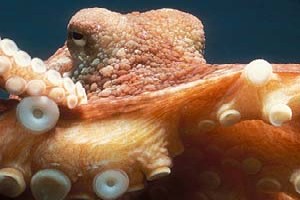 Monterey Bay Aquarium's giant octopus
Monterey Bay Aquarium's giant octopus
Okay, I’m biased. I definitely have my favorite animal in the Steinhart Aquarium and I visit him often. The first time I saw him come out and swim around was magical. It was just before we opened to the public and it had been a long day. I was taking a break in the Aquarium and after strolling for a spell; I sat down by his tank. He was hiding just out of sight in the bottom of the tank squeezed between the glass and the rocky outcroppings. I saw a tentacle, red and furtive and then another one. His face poked up and then dipped down quickly. His tentacles stilled roamed, creating a beautiful line against the glass. He got braver and would peek at me for longer and then dip down yet again. Of course I would be biased –- considering I was able to play peek-a-boo with a red octopus!
That was almost a year ago and I still visit regularly. I can count on two hands the amount of time that I’ve visited his tank to find him out and exploring. Most often he is hiding within one of the corners of the tank. But I catch him out -- hunting a crab or opening a jar the biologist gave him to play with. His elusive nature makes the times I get a glimpse that much more special. He has grown quite a bit over the course of the year and now when he comes, he spreads out and takes up much of the span of the tank. His red coloring, mottled skin and white suckers make him look like a dancing underwater firework.
I am in great awe of his shape and the intelligence he shows in manipulating his form. On the Red Octopus, the only hard substance on its entire body is its beak. These species are invertebrate cephalopods; most species lack either an internal or external structure. Most often them can squeeze into spaces no bigger around then their beak. Which explains why he can fit into such a small corner despite his large size.
Astro-turf is also carpeting the rim of his tank. It is a deterrent against him crawling out of his tank into another tank to feed. A previous octopus on display in the old Steinhart Aquarium did just that, much to the chagrin of the biologists caring for the tanks. There is also a weight on top of the octopus tanks at the tidepool. This is to insure they do not get out and eat the residents of the tidepool. The weight is a couple of pounds, and without it the small octopus could easily open its jewel tank.
